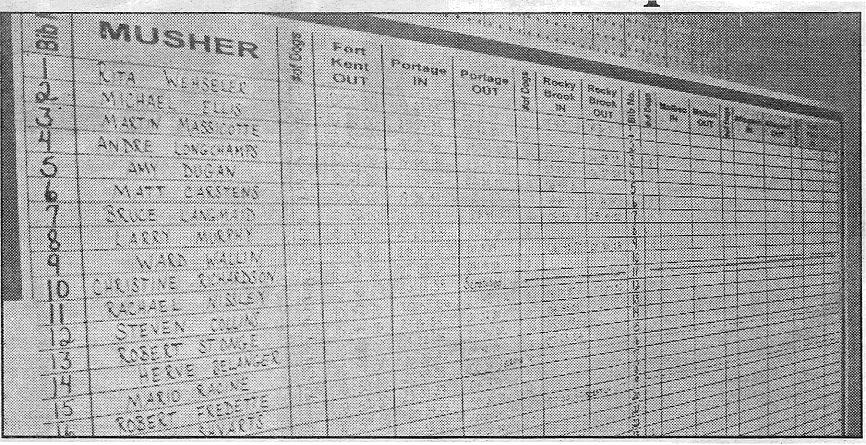


| WHO'S IN FIRST? WHERE ARE: THEY?-Pictured is the dry erase board at Can-Am Headquarters at Lonesome Pine Lodge in Fort .Kent. Using a complicated system of communication through Ham radio, cell phones, and land-based phone lines, Can-Am volunteers meticulously mark times and other pertinent information about each Can-Am Crown 250 team. The dry erase board is just one of the many attractions to be found at "Can-Am Central" --Nadeau photo |
| By Tina H. Nadeau
FORT KENT - Inconspicuously tucked away in the very bottom of Lonesome Pine Lodge exists a command station that few would notice save for the small poster that' reads "Can-Am Headquarters". , The sign receives a few cursory glances, particularly from tunnel-visioned young snowboarders . but for those in the know, Can-Am Headquarters is essentially a one-stop deal for finding out the latest breaking information on mushers and dog sled teams at all points in the race. In this small room (no bigger than a cozy living room), Stan Flagg mans a computer, updating the excellent Can-Am website as times and other information come in. Early Sunday morning, Flagg was entering the arrival time's of teams at one of the 250 race's checkpoints. For those keeping track of the races at home or with their Blackberries, the website (can-am.sjv.net) proves itself an invaluable resource. Biographical and racing data on each of the competition's 90 mushers and their teams, as well as complete listings of results and race times starting from 1993, the history of the Can~Am Crown races is literally at one's fingertips. One of the volunteers at Can-Am Central explained that Flagg doesn't utilize GPS (global positioning system) technology for the popular "tracking" component of the website. Instead, she. explained, Flagg developed a. simple formula for estimating a team's position along the course: distance traveled divided by time equals miles per hour. From that information, the moving "dots" (representing teams) travel according to the calculated speeds. The system has proven so accurate that Flagg, in communication with check point staff at Portage, Rocky Brook, Maibec, and Allagash, can alert the staff as to the arrival times of racing teams, down to the minute. Also staffing Can-Am Central are local volunteers: During the 30 and 60-mile races' awards ceremony, the staffers were Frances Labrie .of Fort Kent, a Can-Am volunteer for 14 years, and Tenley Bennett of Eagle Lake, self-named "Frances's apprentice" in her first year as a race volunteer. Using cell phones, CB radios, the internet, and land line phones, the volunteers are in constant contact with checkpoints, keeping track of arrival, rest, and departure times,· . dropped dogs, .scratched teams, and any other pieces of information that come |
their way. They are also responsible for updating a large dry-erase board with the list of 250 participants, which many family members, handlers, and other mushers stop by to check regularly. Another interesting decorative feature of the .headquarters is a map of the United States and Canada, with push pins representing the hometowns of all the mushers for the year's races. The mushers who traveled the furthest this year were Rick Larson (the Crown 250 winner) and Laura Daugerau (who finished ninth in the Can-Am 60 race), both of whom hail from Sand Coulee, Montana. "This is the hub of the whole Can-Am operation," explained Bennett. "All information comes in here. It's a huge job." Can-Am Central is manned 24 hours a day during the race, with volunteers working in shifts to ensure seamless coverage of the headquarters: French. and English, Valley French and Quebecois French, all mingle together in the headquarters, which became crowded following the awards ceremony. The volunteers trade-off between socializing and responding to visitors' inquiries and taking down information as it is received from the checkpoints and calling various checkpoints to update their information. One visitor, "one of our favorite regulars" explained Labrie, told of his touch with Hollywood: he appeared in several scenes in the dog sledding Disney film Iron Will. A local resident, after speaking with one Of the -- mushers from the shorter races, said, "I speak French. But monsieur over there, he speaks 'French French'." Others, including handlers' and spouses, quickly jotted down the updated information from the dry erase board, then pulled out their cell phones to give updates to those "from away". For the uninitiated or simply curious, Can-Am headquarters should be a required stop during visitors' Can-Am experience. For those far away from Fort Kent; the website provides the next best thing. Through the work of the volunteers in this information hub, as well as those at checkpoints and elsewhere during the races, the times and other racing data remain accurate throughout the Can-Am Crown races for those in town, on the course, or across the world. |